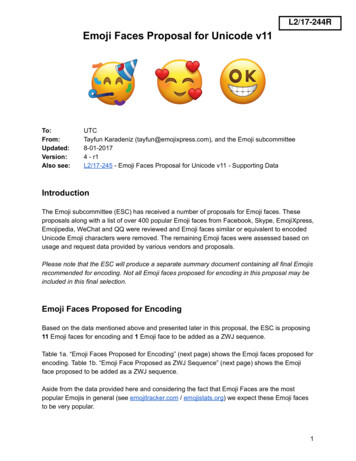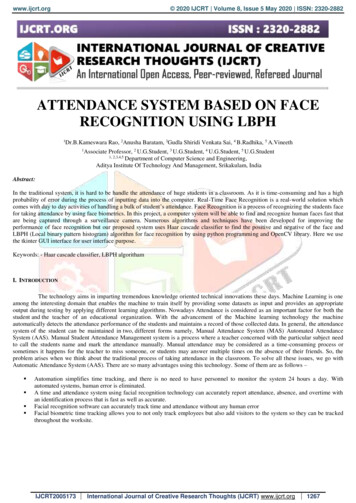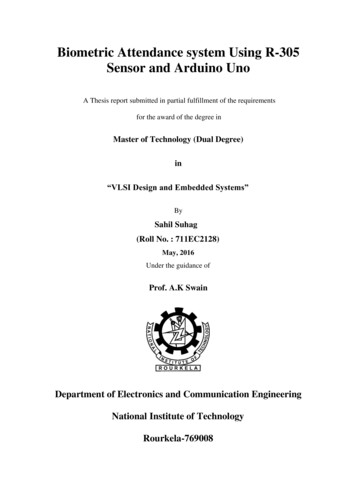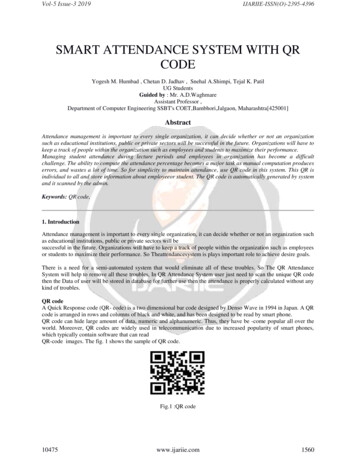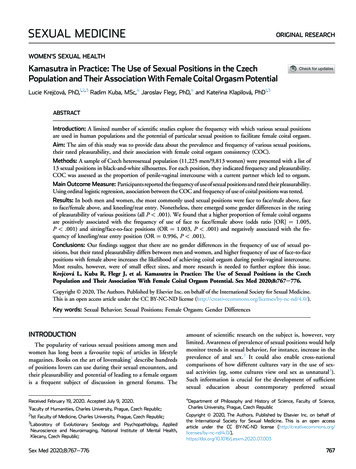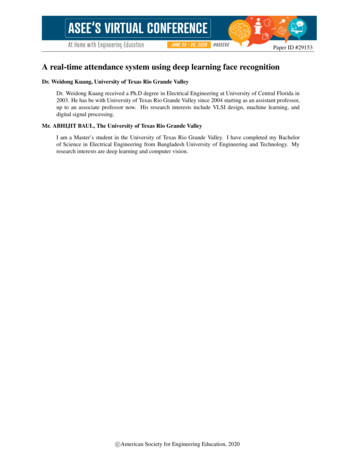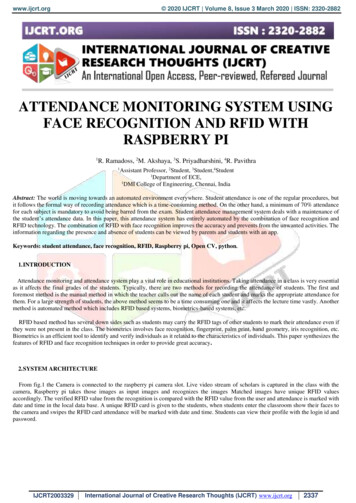
Transcription
www.ijcrt.org 2020 IJCRT Volume 8, Issue 3 March 2020 ISSN: 2320-2882ATTENDANCE MONITORING SYSTEM USINGFACE RECOGNITION AND RFID WITHRASPBERRY PI1R. Ramadoss, 2M. Akshaya, 3S. Priyadharshini, 4R. Pavithra1Assistant Professor, 2Student, 3Student,4Student1Department of ECE,1DMI College of Engineering, Chennai, IndiaAbstract: The world is moving towards an automated environment everywhere. Student attendance is one of the regular procedures, butit follows the formal way of recording attendance which is a time-consuming method. On the other hand, a minimum of 70% attendancefor each subject is mandatory to avoid being barred from the exam. Student attendance management system deals with a maintenance ofthe student’s attendance data. In this paper, this attendance system has entirely automated by the combination of face recognition andRFID technology. The combination of RFID with face recognition improves the accuracy and prevents from the unwanted activities. Theinformation regarding the presence and absence of students can be viewed by parents and students with an app.Keywords: student attendance, face recognition, RFID, Raspberry pi, Open CV, python.1. INTRODUCTIONAttendance monitoring and attendance system play a vital role in educational institutions. Taking attendance in a class is very essentialas it affects the final grades of the students. Typically, there are two methods for recording the attendance of students. The first andforemost method is the manual method in which the teacher calls out the name of each student and marks the appropriate attendance forthem. For a large strength of students, the above method seems to be a time consuming one and it affects the lecture time vastly. Anothermethod is automated method which includes RFID based systems, biometrics-based systems, etc.RFID based method has several down sides such as students may carry the RFID tags of other students to mark their attendance even ifthey were not present in the class. The biometrics involves face recognition, fingerprint, palm print, hand geometry, iris recognition, etc.Biometrics is an efficient tool to identify and verify individuals as it related to the characteristics of individuals. This paper synthesizes thefeatures of RFID and face recognition techniques in order to provide great accuracy.2. SYSTEM ARCHITECTUREFrom fig.1 the Camera is connected to the raspberry pi camera slot. Live video stream of scholars is captured in the class with thecamera, Raspberry pi takes those images as input images and recognizes the images Matched images have unique RFID valuesaccordingly. The verified RFID value from the recognition is compared with the RFID value from the user and attendance is marked withdate and time in the local data base. A unique RFID card is given to the students, when students enter the classroom show their faces tothe camera and swipes the RFID card attendance will be marked with date and time. Students can view their profile with the login id andpassword.IJCRT2003329International Journal of Creative Research Thoughts (IJCRT) www.ijcrt.org2337
www.ijcrt.org 2020 IJCRT Volume 8, Issue 3 March 2020 ISSN: 2320-2882POWERSUPPLYLCDDISPLAYREADERRASPBERRY PI4MODEL BDATABASE&APPCAMERAFigure.1 Block Diagram3. HARDWARE DESCRIPTION3.1 Raspberry PiFigure2. Raspberry pi 4 model BRaspberry pi is a small size computer that uses the ARM processor architecture, which is often used by most modern phones.3.2 RFID ReaderRFID reader is a module that uses RF waves to transmit data between itself and a RFID tag in order to identify, check, categorizeand track assets.3.3 CameraA camera is an optical instrument used to record or capture images which can be stored locally, transmitted to anotherlocation, or both. The camera is a remote sensing module as it senses subjects without any contact.3.4 LCD DisplayLiquid crystal display is a type of flat panel display that uses liquid crystals in its primary style of function.4.PROPOSED SYSTEMThe system covers RFID with face recognition for the attendance monitoring and management. Firstly, students are permitted to registerthe attendance within the allotted time interval using RFID technology. Radio frequency identification (RFID) system is based on twocomponents which are a reader and a tag. The tag is attached to an object and the reader identifies the proper object. The data is transmittedby using radio wave. The RFID tag acts as a transceiver.A typical RFID tag contains of two parts, an integrated circuit and an antenna. The integrate circuit is used for gathering and runninginformation. The function of the antenna is to receive and transmit a signal. There are three types of RFID tags and they are active,passive, battery assistive passive. The RFID tags are equipped with non-volatile memory storage. The RFID reader transmits an encodedradio signal to the RFID tag by using a two-way transmitted receiver which is known as transceiver and interrogate. The FacialRecognition is done using OpenCV library and running the appropriate codes on Python. We have usedOpenCV and respective library files. From the camera, respective persons are identified then, they are permitted to show their card infront of the RFID reader. If both matched the attendance will be marked.IJCRT2003329International Journal of Creative Research Thoughts (IJCRT) www.ijcrt.org2338
www.ijcrt.org 2020 IJCRT Volume 8, Issue 3 March 2020 ISSN: 2320-2882User and RFID cardWeb camera &ReaderDetect user’sfaceRead RFIDcardRecognizefaceIs valid?YESIsmatch?NOYESAttendance markedNOAccess deniedFigure3. Flow diagram of proposed system5.DETAILED DESCRIPTIONThe proposed system has two distinct categories, one is face recognition system and another one is RFID based system.1. Face detection and recognition1.1 OpenCV’s haar cascade detection method is utilized here and LBP face recognizer is used to identify the faces. For face detectionin viola jones we have 4 steps they are:a) Selection of Haar featuresb) Integral imagesc) Adaboostd) Cascade Classifiera) Selection of Haar features:Haar features are used to detect the presence of the features in the given image. Each feature results in a unique value which is computedby the subtraction of sum of pixels under white rectangle from the sum of pixels under black rectangle.Val sum (pixels in black region) - sum (pixels in white region).b) Integral images:The sum of values in a rectangular subset of a grid within the image processing domain it is known as integral image. The value atpixel (x, y) is the sum of pixels above and to the left (x, y).ii (x, y) Σ i (x’, y’)x’ x, y’ yc) Adaboost:In adaboost there are two classifiers they are strong and weak classifiers. The adaboost produces a strong classifier has a linearcombination of the weak classifier.F(x) α1f1(x) α2f2(x) α3f3(x) F(x) Strong classifierαf(x) Weak classifierIJCRT2003329International Journal of Creative Research Thoughts (IJCRT) www.ijcrt.org2339
www.ijcrt.org 2020 IJCRT Volume 8, Issue 3 March 2020 ISSN: 2320-2882d) Cascade Classifier:The cascade classifier is used for the composition of stages where each stage contains a strong classifier when all the features arejoined into different stages where each stage as number of features. Those each stage is used to determine whether it’s a face or not aface.1.2 The face recognition is done by implementing Local Binary Patterns (LBP). The image features are extracted using LBPs, thenLBPs algorithm compares the extracted features with the trained datasets. Local Binary Pattern is an efficient texture tool which isemployed to label pixels of an image that is obtained from detection. LBP thresholds the neighborhood of every pixel and produces abinary number. The first step in this is to construct grayscale image.For each pixel in the gray scale image, neighborhood of pixel size r is surrounded by the center pixel. The LBP value is computedfor this center pixel and stored in the output array with the same width and height of the input image. Since every centered pixel has 8pixels-3x3 surrounding neighbors, it can be denoted as a binary number. If any neighbor is greater or equal than the central pixel then alogic ‘1’ bit is replaced for that pixel, else logic ‘0’ bit is replaced for that pixel. Then, the 8 bits binary number is converted to decimalwhich represents the threshold of that centered pixel value. The last step is to calculate histogram over the output LBP array.2. RFID based systemAfter face recognition, students are allowed to show their RFID tags over the reader which reads the tag value. Then, the tag valueobtained from face recognition is compared with this tag value. If it is matched, the attendance will be marked.Figure4. Implementation methodThe attendance is stored in the respective database which is enrolled with the student’s details in prior to have the attendancemanagement system up-to-date. LCD display is placed to show the respective results over the system working. According to the student’sentry the system is proposed to identify them and made to be reliable to use in real time applications.5.CONCLUSION:Thus, in this way we proposed a system which works on the combination of RFID and face recognition. And with just fewmodifications we can use our system in any secured facilities. Usage of Python and Open CV in Raspberry Pi made our project flexibleand adoptable to any required future changes. This paper gives the efficient and accurate method of attendance in educational institutionswhich replaces the manual method. It is highly flexible and reliable to use. As the attendance percentage affects the grades of the student,it is very useful when it gets automated which provides accurate results and user friendly. Hence, this automated system can be a greatmodel for managing the attendance.6.FUTURE SCOPE:The proposed method is established for recording the attendance for students and staffs in educational institutions. This system can beimplemented in many work sectors such as banks, companies etc. The implementation can be made in both private and governmentsectors. Instead of face recognition any other biometrics may combined with RFID system. In ATMs, this face or IRISrecognition approach can be utilized for accessing the accounts-which could be a more successful and authorized way of banking. Insteadof raspberry pi this system can be made with ODROID XU4 portable computer.IJCRT2003329International Journal of Creative Research Thoughts (IJCRT) www.ijcrt.org2340
www.ijcrt.org7. REFERENCES 2020 IJCRT Volume 8, Issue 3 March 2020 ISSN: 2320-28821] Shreyak Sawhney, Karan Kacker ,Samyak Jain, Shailendra Narayana Singh,Rakesh Garg, “Real - Time Smart Attendance Systemusing Face Recognition Technique”, in 9th International Conference on Cloud Computing ,Data Science &Engineering, 2019.[2] Danijel Mijic, Ognjen Bjelica, Jelena Durutovic,Milos Ljubojevic,”An improved version of student attendance management systembased on RFID”,in 18th International Symposium INFOTECH –JAHORINA, 20-22 March 2019.[3] Domingo Mery, Ignacio Mackenney,Esteban Villalobos, “Students Attendance System in Crowded Classroom Using A Smart PhoneCamera”, in IEEE winter conference on application of computer vision ,2019.[4] Fawaz Alassery, “A Smart Classroom of Wireless Sensor Networks for Students Time Attendance System”, in IEEE integrated STEMeducation conference (ISEC), 2018.[5] Omar Abdul Rhman Salim, Rashidah Funke Olanrewaju, Wasiu Adebayo Balogun ,”Class Attendance Management System UsingFace Recognition”, in 7th International Conference on Computer and Communication Engineering, 2018.[6] Khin San Myint,Chan Mya Mya Nyein, “Fingerprint Based Attendance System Arduino”,in International Journal of Scientific andResearch publication, July 2018.[7] Priya Pasumarti, Purna Sekhar, “Classroom Attendance Using Face Detection and Raspberry pi,” in International Research Journalof Engineering and Technology (IRJET), March 2018.[8] D. Santhi Priya, M. Uma Sankar, “Modern Attendance System Using Raspberry pi”,in International Research Journal of Engineeringand Technology (IRJET), August 2016.[9] Mandeep Kaur, Manjeet Sandhu, Neeraj Mohan, Parvinder S. Sandhu, “ RFID Technology Principles, Advantages, Limitations & ItsApplications” in International Journal of Computer and Electrical Engineering, Vol.3, No.1, February 2011.[10] Gyanendra K Verma, Pawan Tripathi, “A Digital Security System with Door Lock System Using RFID Technology”, in InternationalJournal of Computer Applications, August 2010.IJCRT2003329International Journal of Creative Research Thoughts (IJCRT) www.ijcrt.org2341
Student attendance is one of the regular procedures, but it follows the formal way of recording attendance which is a time-consuming method. On the other hand, a minimum of 70% attendance for each subject is mandatory to avoid being barred from the exam. Student attendance management system deals with a maintenance of the student's attendance .
